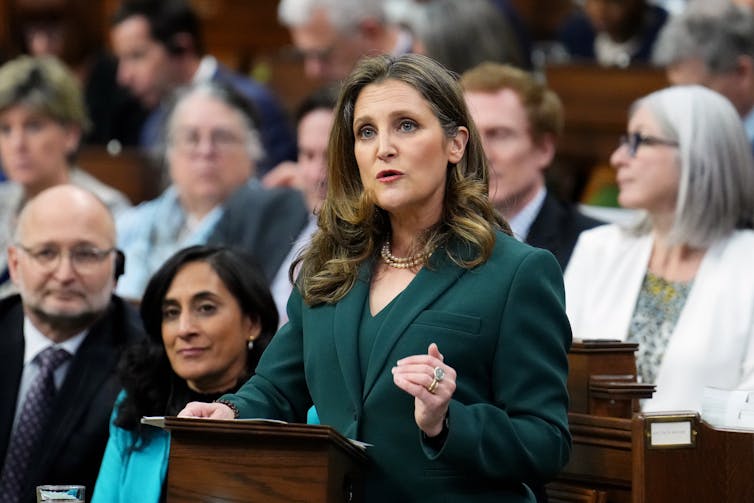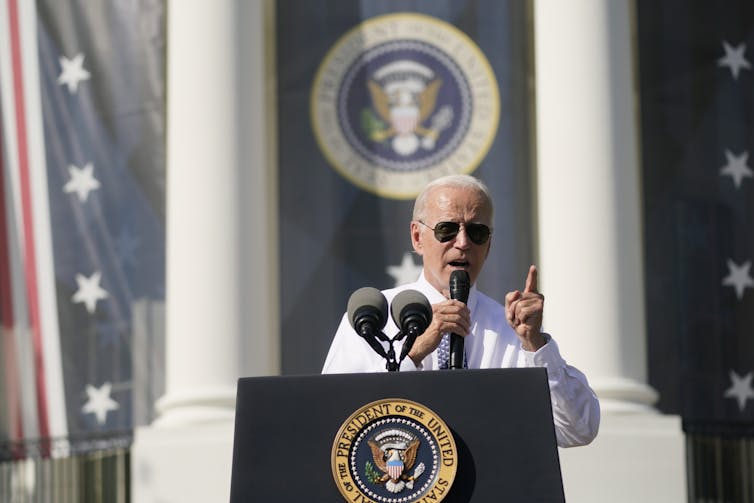
Canada committed to the United Nation Sustainability Development Goals (SDGs) in 2015. These 17 goals aim to “achieve peace and prosperity for people and the planet.” This is an important, yet challenging, undertaking.
The goals aim to establish a “global partership” to address the pressing issues of our time. Some of these issues include reducing inequalities, promoting quality education, addressing climate change and protecting biodiversity.
When taking action to reduce our impact on the environment, a key challenge is how to transition to cleaner economies. The costs and risks of such an undertaking are clearly not trivial.
An important issue facing the country now is how to prioritize this transition in the face of unaffordable housing, rising interest rates and an uncertain future for upcoming generations.
Economic uncertainty
It’s a difficult time for Canadians to consider transitioning to a cleaner, more sustainable future. Canada is projected to have one of the lowest gains in average living standards over the next seven years, according to a study from the Organisation for Economic Co-operation and Development.
There are a few reasons for this prediction. One is Canada’s low level of labour productivity in comparison to other nations like France, the United Kingdom and Italy.
Read more: Canada's lagging productivity affects us all — and will take years to remedy
Another concern is Canada’s level of household debt, which is now the highest in the G7, according to the Canada Mortgage and Housing Corporation. Canada’s high housing prices, and resulting high levels of debt, are likely stifling economic growth.
In the face of such economic uncertainty, is it worth investing in a more sustainable Canada, or will it become just another economic burden? The hope is that it will provide an opportunity for Canada to fix some of its more significant problems. It could be Canada’s best hope to improve its economic fortunes.
Co-ordinated response needed
To achieve a sustainable future that benefits Canadians, a co-ordinated response from a variety of stakeholders — including households, businesses and the government — is essential.
Such a response needs businesses up front and centre. One reason for this is that much of the world’s CO2 emissions come from businesses.
However, it is also vital that businesses are supported because companies can innovate and thrive, ensuring that sustainability and prosperity can be realized.
Ahead of the Government of Canada’s March 2023 budget announcement, accounting firm KPMG surveyed medium-sized enterprises.

They found that Canadian businesses are ready to embrace their role in achieving sustainability, but 80 per cent want more support from the government. This includes assistance for capital investment, tax incentives and tax credits.
These measures would make it easier for companies to adopt clean technologies. They would also be crucial for helping Canadian companies compete with their American and European counterparts, which are already receiving green incentives.
Global green incentives
Other countries, like the U.S., are shoring up their competitiveness and positioning themselves for a cleaner economy. The U.S. committed nearly US$370 billion to clean energy in its Inflation Reduction Act of 2022.
In response, the European Union published its Green Deal Industrial Plan in February 2023 to support Europe’s net-zero industry and help it transition to climate neutrality. This included 520 billion euros in support through the Recovery and Resilience Fund and REPowerEU fund.

EU member nations have also responded individually. For instance, France announced a tax credit for renewable investments earlier this month.
Critics might see this trend as a “race to the bottom” in terms of subsidies and protectionist trade measures. Others, however, might see it as a global effort toward growing market competitiveness.
The desired outcome is a win-win scenario where all market participants benefit through combined global climate action and green investment.
Federal budget
The federal government seems to agree that creating a green economy is Canada’s greatest opportunity to generate growth. The 2023 budget outlines C$70 billion in investments to address Canada’s competitiveness and transition to clean energy.
This includes a strong package of tax incentives for clean energy, particularly for clean electricity and clean technology manufacturing.
Deputy Prime Minister and Minister of Finance Chrystia Freeland said she had “never been more optimistic” about the future of Canada than she was on the day the federal budget was announced.
The list of green incentives baked into the 2023 budget is not exhaustive. However, it demonstrates that the federal government is trying to position Canada to be a more competitive, cleaner economy.
More work to be done
Given the package of measures in the 2023 budget, Canadian businesses are now better positioned to contribute to saving the planet. However, to compete in the clean economy space they will need continuing support as they seek to compete with other nations.
How this support will manifest is difficult to say, but Canada must take a global perspective when considering the best approach. It needs to be especially mindful of similar budget decisions from other major economies and the potential impact these will have on Canada’s fledgling clean economy.
Will there likely be further tax incentives in the future? We can suspect so.
But more tax incentives are not the only way to provide support. For example, Canada has not clarified how it will manage regulatory issues regarding large clean energy projects. This is an important issue that could either promote or deter clean energy investment.
Some in the research and development sector also felt there was a missed opportunity for Canada to invest in its own research capacity to develop the talent needed to ensure the clean economy’s success.
While efforts are being made at the highest levels, there is still much work to do.
The authors do not work for, consult, own shares in or receive funding from any company or organisation that would benefit from this article, and have disclosed no relevant affiliations beyond their academic appointment.
This article was originally published on The Conversation. Read the original article.







